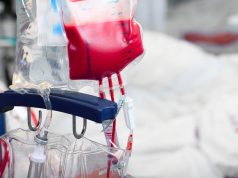Treatment of iron deficiency anemia linked to improvements in vitamin B12, folate, lipids
FRIDAY, May 15, 2015 (HealthDay News) — For young women with iron deficiency anemia (IDA), iron therapy is associated with increases in serum folate, vitamin B12, and with other biochemical parameters, according to a study published online May 11 in the International Journal of Laboratory Hematology.
Angel F. Remacha, M.D., from Hospital de Sant Pau in Barcelona, Spain, and colleagues examined vitamin B12/folate changes during treatment of IDA in a cohort of 35 young adult women. At four-month follow-up, a hematological response was obtained in 97.2 percent of participants. The authors monitored changes in serum vitamin B12, serum folate, and other biochemical parameters.
The researchers found that iron treatment correlated with significant increases in serum folate and vitamin B12 from baseline. This increase was also seen in six patients with vitamin B12 levels ≤200 pmol/L, who had serum vitamin B12 levels above 200 pmol/L at the study end. Changes were seen in other biochemical parameters, with significant increases in glucose, uric acid, total cholesterol, high-density lipoprotein cholesterol, and bilirubin. There was a significant decrease in urea.
“Data from our work suggest that iron deficiency could affect many metabolic pathways, including vitamin B12, folate, and lipids. These changes normalize after iron therapy, even in women with baseline low levels of serum vitamin B12,” the authors write. “Health care practitioners should be aware of these changes in IDA management.”
Copyright © 2015 HealthDay. All rights reserved.








